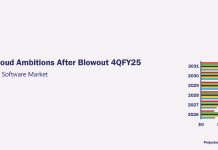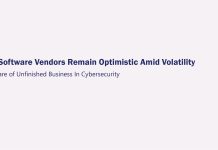
As Cloud services are changing the buying experiences for companies large and small, major vendors like Oracle and SAP are investing heavily in their service and support operations to better differentiate from the competition.
If their gambit pays off, it could usher in a new way to boost the overall value of enterprise software by emphasizing reliability and a run-better and risk-free application landscape, ultimately resulting in better service and support experiences for customers.
A key reason that enterprise software service and support warrants special attention is that the component is at least three times the size of the license revenues, according to our latest survey of more than 1,200 enterprise applications vendors. It was more than two times at SAP in 2017, three times at Cerner the healthcare software giant and four times at ERP heavyweight Infor and more than 10 times at Constellation Software, which has become a $2.5 billion enterprise apps juggernaut by accumulating more than $1.6 billion worth of maintenance fees after buying scores of vendors every few years for their recurring revenue streams.
Because of the long history of their ERP market presence, the stake is high for these vendors to enrich and extend their installations by not just accelerating Cloud migration, but also the periodic and sometimes much-dreaded upgrades that their customers have to endure from one release to the next.
Their new programs form the basis of this two-part series, shining a new light on their ramifications for customers, or for that matter, the enterprise software marketplace. You can read the second part here.
Oracle Upgrades Service and Support
In the case of Oracle, the recent developments are both breathtaking and revealing as to the depth and magnitude of service and support changes taking place at the giant database and applications vendor.
It all started in September 2017 when Oracle unveiled its Bring Your Own License plan, which enables its customers to convert its software licenses to Cloud subscriptions. Any systematic conversion by its license customers to Cloud subscriptions – especially for Platform As A Service the preferred way for Oracle to sell its latest database services – could signal a further erosion of its on-premise software license sales, while multiplying its Cloud subscription revenues. However one of the biggest benefits of the Bring Your Own License program is that it enables users to address the shelfware issue as they are able to license what they want, use the software as they see fit and convert it to something else that is tangible when necessary.
Then in May 2018, Oracle announced free Platinum-Level support to its applications customers, essentially giving away premium service offerings – including 24×7 technical support, dedicated implementation support, proactive technical monitoring, a new online learning platform called Oracle LaunchPad and others – for customers using Oracle Cloud Applications for ERP, HCM, SCM and other mission-critical functions.
Oracle followed that up with the Oracle Soar offering in June 2018, covering a range of capabilities such as discovery assessment, process analyzer, automated data and configuration migration utilities, and rapid integration tools all designed to accelerate the upgrade processes for E-Business Suite, PeopleSoft Enterprise and Hyperion Planning customers to Oracle ERP Cloud, Oracle SCM Cloud and Oracle EPM Cloud.
Culminating these developments was Oracle’s latest move in June to reclassify its onpremise maintenance and Cloud subscription revenues into a single line item called Cloud Services and License Support, which now accounts for two-thirds of its revenues now topping $40 billion in fiscal 2019.
The new line item is also emerging as the top priority for Oracle to invest in its future. In fact, it’s the only P&L that saw a 6% growth in its headcount from 17,000 to 18,000 between fiscal 2017 and fiscal 2018 ended on May 30, while the number of full-time employees for the entire company dropped from 138,000 to 137,000 during the period. In fiscal 2018, every other part of Oracle from R&D to operations and from sales and marketing to professional services either experienced contraction or no growth at all.
Combining the high-growth Cloud Services (which cover service and support operations of its IaaS, PaaS and SaaS offerings) with the high-margin onpremise license support division will help Oracle streamline the service and support processes for all customers using the same standard framework. That’s one of the drivers behind Oracle upping the ante by giving away Platinum-Level to its Cloud applications customers, something that its onpremise customers had to pay extra for in the past. It’s almost similar to the ploy used by Amazon to give away its free-shipping service to certain customers of Whole Foods for a few months enticing them to eventually buy into the ease and convenience of the Prime membership.
What matters to Oracle is to change the perceived value of its service and support operation, transforming it from an expense item in the minds of end users to something akin to business assurance and even dividends. After all, who doesn’t want to run a piece of software from a company, knowing that it could be trusted, secure and comprehensive as part of running a business today and tomorrow?
For Oracle, or any enterprise software vendor for that matter, the imperative is that customer expectations are changing quickly with growing popularity of Cloud applications. Few users now give second thoughts that the subscription revenues that they are paying are mostly made up of service and support components that keep the software running 24×7. The ease for anyone to access Google does not negate the fact that someone else is shouldering the burden of keeping some far-flung data centers humming. When those daunting tasks are out of sight and out of mind for end-users, it’s inconceivable that any of them would want to assume the costs of doing those things themselves.
For most users – especially those that have a mix of onpremise and Cloud applications – turning that over to a single source like Oracle that can shoulder such burdens with its recent service and support initiatives is considered economical and sensible.
Equally compelling is the rise of third-party support firms like Rimini Street and Spinnaker Support, which have made a bundle selling cut-rate support and services for a range of enterprise software products from Oracle to SAP and more recently Cloud products like Salesforce.
The question is whether these support organizations with limited resources can handle the increased demands of patching or delivering adequate and timely updates to support many different products, all of which have their own set of built-in compliance, legislative, security, integration requirements.
By contrast, with thousands of resources dedicated to servicing and supporting its products(database, apps and others), Oracle boasts one of the most biggest efforts in the enterprise software industry to ensure its updates are in full compliance above and beyond what a secure and scalable IT environment would demand from both horizontal and industry-specific perspectives.
Another advantage Oracle enjoys over its competition is its ability to deliver better integration between horizontal products for systems like ERP and vertical solutions such as costing and project management apps for construction and engineering firms. In April 2018, Oracle acquired Aconex for $1.6 billion in the building information management and collaboration space after buying Textura, Skire, Instantis, and Primavera, all of which are being used extensively among construction and engineering firms. It would be incumbent on Oracle to orchestrate and deliver the service and support needed to integrate and run such applications effectively on behalf of thousands of customers.
Evolving Service and Support Needs
The biggest challenge facing enterprise software vendors is to convince their customers the intrinsic value of service and support, involving and oftentimes bolstering every single Cloud conversion or legacy system upgrade, akin to what vehicle subscription services are doing to transform the car ownership experiences.
It’s also incumbent on enterprise applications users to be proactive in rethinking the model of licensing and extending a piece of software through maintenance will not only help them achieve better productivity and peace of mind, but also find room for co-innovation with their vendors to drive their digital transformation initiatives together.
The future of enterprise software service and support will be based on the mutual understanding that a blanket service and support arrangement does not result in vendor lock-in. In addition, users have every right to demand full compliance of the pre-requisite security and legislative updates that they are entitled to even with the bundling or unbundling of service and support options in every license or Cloud subscription deal.
In an ideal world, every software purchase should be viewed through the lens of continuous value generation for all the parties involved. And it’s entirely up to the vendors and their customers to make sure it happens.





